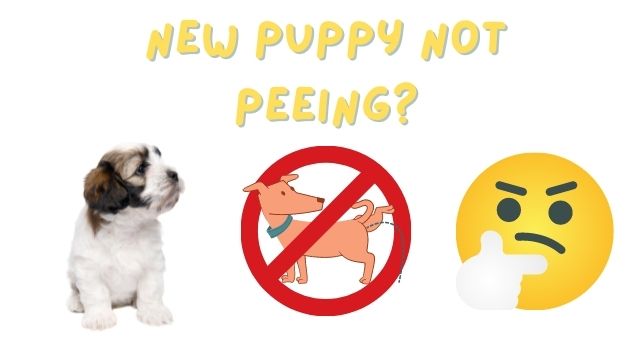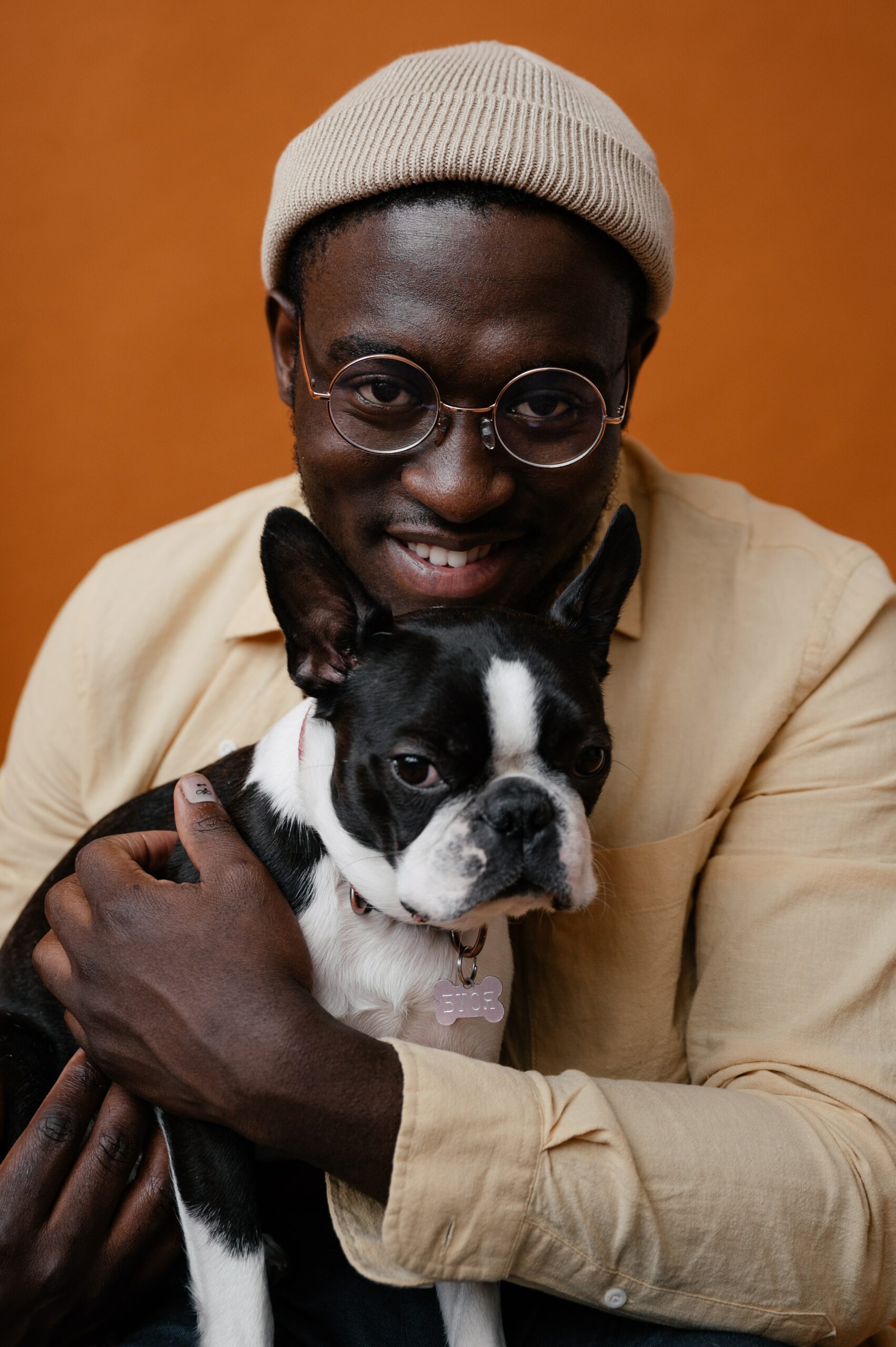From peeing too much through peeing on couches and other inappropriate places to not peeing at all – we find many dog urination habits to be strange and worrisome. If you are a first-time dog parent and your new puppy is not peeing, chances are you are concerned.
So, new your new puppy is not peeing – is this normal? Yes, a newly brought home puppy may need some time to adjust before it starts peeing. Also, there is a possibility that the puppy was housetrained by the breeder and now does not know where to pee in the new home. However, if you have had the puppy for over a day and there is still no urine, you need to call the vet and schedule an appointment.
In this article, we will talk about the reasons a new puppy might not be peeing. We will also talk about how long a puppy can go without peeing and, finally, give helpful tips on what to do in case your new puppy does not pee.

Why Is My New Puppy Not Peeing?
There are several reasons why a new puppy may fail to pee. Some are transient and normal, while others are more serious and indicative of underlying issues.
If you got a new puppy and it refuses to pee, the following scenarios are highly plausible.
Reason Number 1: The Puppy Is Too Stressed to Pee
Stress has a huge impact on the puppy’s overall behavior. Being separated from the mother and siblings is too stressful. The new environment and the car ride to the new home only add to the stress. A stressed puppy will refuse to pee or even refuse to eat in more severe cases.
Reason Number 2: The Puppy Is Housetrained Differently
There is a small chance that the puppy is already housetrained and used to peeing in a way you are not providing. For example, if the breeder used puppy pads and you do not have pads available at the puppy’s disposal, chances are it does not know where to go.
Reason Number 3: The Puppy’s Fur Is Heavily Matted
If the puppy comes from an irresponsible breeder, there is a chance of matted fur blocking the urinary opening. Such mechanical obstruction will prevent the puppy from properly peeing (or even make the peeing painful).
Reason Number 4: The Puppy Has a Medical Condition
Rarely, the reason your new puppy is not peeing can be an underlying medical condition. Such conditions are more likely in newborns and adults, but there are slim chances puppies can be affected too.
Reason Number 5: The Puppy Is Peeing but Secretly
There is always a chance that the puppy peed, but you cannot find the “crime scene.” The small pee puddles puppies make can be hard to spot, especially if present in unusual places.
Reason Number 6: The Puppy Is Dehydrated
This is a relatively uncommon reason but definitely worth mentioning. A dehydrated puppy will not pee simply because there is no urine to be eliminated. Dehydration is more possible if the puppy was bought from an irresponsible breeder or if it traveled for long before reaching your home.
How Long Should a Puppy Go Without Peeing?
In theory, a puppy can go without peeing for one hour per every month of age. In more practical terms, a 2-month old puppy can hold it for two hours, a 3-month old puppy for three hours, and so on.
However, some puppies can hold it for longer and others for shorter timeframes. Just like people, all puppies are different.
The general rule of thumb is that a puppy or dog not peeing for over 12 hours is considered problematic and warrants proper veterinary attention – to determine the underlying cause and provide solutions.
What Do I Do if My Puppy Won’t Pee?
If your new puppy is not peeing, do not raise red flags. Some puppies need more time to adjust to the new environment and will start the pee and poop as soon as they feel relaxed and comfortable.
To make sure your puppy is healthy and everything is normal, there are several steps you can take.
Step Number 1: Evaluating the Overall Situation
First of all, you need to assess the entire situation. For example, give it some time if the puppy is acting normal and the only issue is the not-peeing. On the other hand, if the puppy is manifesting other troublesome signs and symptoms in addition to not peeing, you need to call the vet immediately and have your puppy thoroughly checked.
Step Number 2: Looking for Hidden Pee
Before panicking, you need to make sure whether the puppy is truly not peeing. Namely, puppies are small and produce tiny amounts of urine. The puppy might have peed, and the carpet absorbed everything. Or the puppy may have peed in a hard-to-reach place like under the couch or behind the flower pots.
Step Number 3: Checking with The Breeder
Call the breeder and ask whether he started house training the puppy. Although most breeders do not do this, there is always a chance. Ideally, it would help if you talked with the breeder on this matter even before you get the puppy. That way, you will make the necessary arrangements and be ready once the puppy is home and needs to pee.
Step Number 4: Making a Quick Vet Visit
Urinary conditions, especially those that can lead to lack of peeing, are rare in young puppies. In adults, the most common culprit would be urinary stones and blockage, while in newborn puppies, the suspicion is on congenital malformations. Anyway, it does not hurt to check with the vet and make sure your puppy is healthy.
Step Number 5: Crating the Puppy
As mentioned, the puppy might be peeing but in secret places. Considering the puppy’s size, the pee puddle is likely to be small and hard to find. Plus, puppy pee is not heavily scented. To keep track of whether the puppy is peeing or not, you can put it in a padded crate. That way, you will easily spot even the smallest pee puddle.
Step Number 6: Putting Pee Pads Everywhere
Crates are a hot topic among dog parents and trainers. Therefore, if you do not want to use a crate, you can put pee pads everywhere (in all areas of the house the puppy has access to). Once again, the goal is the same – to be able to monitor whether the puppy urinates or not. Obviously, checking such a large area is more challenging than checking a crate.
Housetraining A New Puppy That Won’t Pee
House training a new puppy that won’t pee can be challenging, but with patience and consistency, you can help them develop proper bathroom habits.
There are multiple steps you can take to make sure your new puppy not only starts peeing, but lets you know when it needs to.
Step Number 1: Establish A Routine
Set a consistent schedule for feeding, watering, and potty breaks. Puppies typically need to eliminate shortly after eating, drinking, playing, or waking up from a nap. Take your puppy outside to their designated potty area at regular intervals throughout the day.
Step Number 2: Supervise and Restrict Access:
Keep a close eye on your puppy to prevent accidents indoors. Use baby gates or a crate to confine them to a small area or room when you cannot actively supervise. This helps you monitor their behavior and prevents them from sneaking off to eliminate in hidden corners.
Step Number 3: Use Positive Reinforcement:
When your puppy successfully pees outside, immediately praise and reward them with treats or verbal praise. Positive reinforcement helps them associate peeing outdoors with positive experiences and encourages them to repeat the behavior.
Step Number 4: Taking Your Puppy To The Same Spot
Lead your puppy to the same designated potty area each time you take them outside. The familiar scent can help trigger the urge to eliminate. Use a consistent command, such as “Go potty” or “Do your business,” to reinforce the desired behavior.
Step Number 5: Be patient and Consistent:
Remember that accidents are part of the learning process. If your puppy has an accident indoors, do not scold or punish them. Instead, clean up the mess thoroughly and calmly. Reacting with anger or frustration may confuse or scare the puppy, making them reluctant to eliminate in your presence.
Step Number 6: Watch For Signs
Learn to recognize your puppy’s signals when they need to go. Signs may include sniffing the ground, circling, or becoming restless. They may also stand near the door or find a secluded area in the house to go. If you notice these behaviors, take them outside immediately.
Remember, consistency, positive reinforcement, and patience are key when house training a puppy. With time, your puppy will learn where to pee and develop good bathroom habits.
Final Words
A new puppy that does not pee can be concerning, especially if this is your first experience as a dog parent and everything is new to you.
However, in most cases, new puppies can go without peeing for a couple of hours, and this is not something you need to be worried about.
Make sure you carefully observe your new puppy’s behavior – if there are other worrisome signs, visit the vet. If the puppy is acting normal, be patient as your puppy will eventually decide to relieve itself.
Also, it would be best if you talked to the breeder when picking up the puppy about its previous habits – where it peed, how often it peed, whether the breeder started with some form of potty training, etc.

